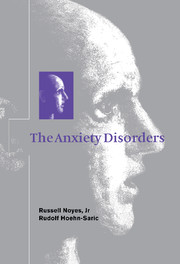Book contents
- Frontmatter
- Contents
- Preface
- 1 Normal anxiety and fear: psychological and biological aspects
- 2 Generalized anxiety disorder
- 3 Panic disorder and agoraphobia
- 4 Social phobia
- 5 Specific phobia
- 6 Posttraumatic stress disorder
- 7 Anxiety in the medically ill: disorders due to medical conditions and substances
- Index
4 - Social phobia
Published online by Cambridge University Press: 22 March 2010
- Frontmatter
- Contents
- Preface
- 1 Normal anxiety and fear: psychological and biological aspects
- 2 Generalized anxiety disorder
- 3 Panic disorder and agoraphobia
- 4 Social phobia
- 5 Specific phobia
- 6 Posttraumatic stress disorder
- 7 Anxiety in the medically ill: disorders due to medical conditions and substances
- Index
Summary
Definition
Social phobia is an unreasonable fear of embarrassing oneself in social or performance situations. In its milder or more circumscribed forms, it causes people to avoid activities such as speaking or eating in public that are an important part of social functioning. In its more severe and generalized forms, it imposes crippling restrictions that result in social isolation and loneliness. It is perhaps the most prevalent and disabling of the anxiety disorders yet is responsive to treatment. Still, few persons seek this treatment, viewing their problem as a form of shyness or inherent weakness to be endured. Added to this, mental health professionals have, until recently, been slow to diagnose and treat the condition.
Descriptions of social anxiety and phobias date from antiquity. Hippocrates had a patient, described by Burton (1621), who ‘through bashfulness, suspicion, and timorousness, will not be seen abroad; … his hat still in his eyes, he will neither see, nor be seen by his good will. He dare not come in company, for fear he should be misused, disgraced, overshoot himself in gesture of speech, or be sick; he thinks every man observes him … ’. Social phobia was first described in the USA by Beard (1879) and in France by Janet (1903). The disorder was later separated from other phobias by Marks & Gelder (1966) and Marks (1970). These authors included ‘fears of eating, drinking, shaking, blushing, speaking, writing or vomiting in the presence of other people’ as well as more general fears of initiating conversations or dating, and they identified the core feature as a fear of appearing ridiculous to others.
- Type
- Chapter
- Information
- The Anxiety Disorders , pp. 158 - 204Publisher: Cambridge University PressPrint publication year: 1998



